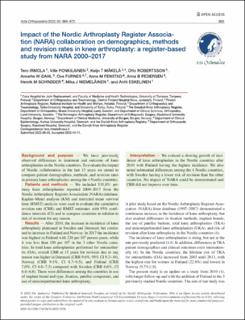| dc.contributor.author | Irmola, Tero | |
| dc.contributor.author | Ponkilainen, Ville | |
| dc.contributor.author | Mäkelä, Keijo T. | |
| dc.contributor.author | Robertsson, Otto | |
| dc.contributor.author | W-Dahl, Annette | |
| dc.contributor.author | Furnes, Ove Nord | |
| dc.contributor.author | Fenstad, Anne Marie | |
| dc.contributor.author | Pedersen, Alma B. | |
| dc.contributor.author | Schrøder, Henrik M. | |
| dc.contributor.author | Niemeläinen, Mika J. | |
| dc.contributor.author | Eskelinen, Antti | |
| dc.date.accessioned | 2023-01-18T09:48:56Z | |
| dc.date.available | 2023-01-18T09:48:56Z | |
| dc.date.created | 2022-12-16T11:13:06Z | |
| dc.date.issued | 2022 | |
| dc.identifier.issn | 1745-3674 | |
| dc.identifier.uri | https://hdl.handle.net/11250/3044217 | |
| dc.description.abstract | Background and purpose: We have previously observed differences in treatment and outcome of knee arthroplasties in the Nordic countries. To evaluate the impact of Nordic collaboration in the last 15 years we aimed to compare patient demographics, methods, and revision rates in primary knee arthroplasties among the 4 Nordic countries.
Patients and methods: We included 535,051 primary knee arthroplasties reported 2000–2017 from the Nordic Arthroplasty Register Association (NARA) database. Kaplan–Meier analysis (KM) and restricted mean survival time (RMST) analysis were used to evaluate the cumulative revision rate (CRR) and RMST estimates with 95% confidence intervals (CI) and to compare countries in relation to risk of revision for any reason.
Results: After 2010, the increase in incidence of knee arthroplasty plateaued in Sweden and Denmark but continued to increase in Finland and Norway. In 2017 the incidence was highest in Finland with 226 per 105 person-years, while it was less than 150 per 105 in the 3 other Nordic countries. In total knee arthroplasties performed for osteoarthritis (OA), overall CRR at 15 years for revision due to any reason was higher in Denmark (CRR 9.6%, 95% CI 9.2−10), Norway (CRR 9.1%, CI 8.7−9.5), and Finland (CRR 7.0%, CI 6.8−7.3) compared with Sweden (CRR 6.6%, CI 6.4−6.8). There were differences among the countries in use of implant brand and type, fixation, patellar component, and use of unicompartmental knee arthroplasty.
Interpretation: We evinced a slowing growth of incidence of knee arthroplasties in the Nordic countries after 2010 with Finland having the highest incidence. We also noted substantial differences among the 4 Nordic countries, with Sweden having a lower risk of revision than the other countries. No impact of NARA could be demonstrated and CRR did not improve over time. | en_US |
| dc.language.iso | eng | en_US |
| dc.publisher | Medical Journals Sweden | en_US |
| dc.rights | Navngivelse-Ikkekommersiell 4.0 Internasjonal | * |
| dc.rights.uri | http://creativecommons.org/licenses/by-nc/4.0/deed.no | * |
| dc.title | Impact of the Nordic Arthroplasty Register Association (NARA) collaboration on demographics, methods and revision rates in knee arthroplasty: a register-based study from NARA 2000–2017 | en_US |
| dc.type | Journal article | en_US |
| dc.type | Peer reviewed | en_US |
| dc.description.version | publishedVersion | en_US |
| dc.rights.holder | Copyright 2022 the authors | en_US |
| cristin.ispublished | true | |
| cristin.fulltext | original | |
| cristin.qualitycode | 1 | |
| dc.identifier.doi | 10.2340/17453674.2022.5256 | |
| dc.identifier.cristin | 2094263 | |
| dc.source.journal | Acta Orthopaedica | en_US |
| dc.source.pagenumber | 866-873 | en_US |
| dc.identifier.citation | Acta Orthopaedica. 2022, 93, 866-873. | en_US |
| dc.source.volume | 93 | en_US |

